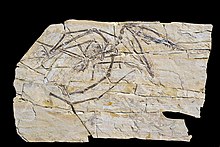| Wukongopterids | |
|---|---|

| |
| Fossil specimen of Darwinopterus modularis | |
| Scientific classification | |
| Domain: | Eukaryota |
| Kingdom: | Animalia |
| Phylum: | Chordata |
| Order: | †Pterosauria |
| Clade: | †Darwinoptera |
| Family: | †Wukongopteridae Wang et al., 2009 |
| Type species | |
| †Wukongopterus lii Wang et al., 2009
| |
| Genera | |
| |
Wukongopteridae is a group of basal pterosaurs, found in China and the UK. It contains eight species in five genera, all dated to the Middle to Late Jurassic period,[1]
The Wukongopteridae were first named by Wang et al. in 2009, not yet giving an exact definition.[2] The clade Wukongopteridae was first defined by Wang et al. in 2010 as "the most recent common ancestor of Wukongopterus lii and Kunpengopterus sinensis, and all of its descendants".[3]
Description[edit]

Wukongopterids are characterized by a unique combination of "primitive" and advanced pterosaurian features. While they had long tails and other features characteristic of other "rhamphorhynchoids", they also had distinct pterodactyloid features, such as long vertebrae in the neck and a single skull opening in front of the eyes, the nasoantorbital fenestra (in most "rhamphorhynchoids", the antorbital fenestra and the nasal opening are separate).[3] This feature lead to Darwinopterus modularis being placed by Lü e.a. in a new clade of pterosaurs, the Monofenestrata, or "with a single opening", forming this group together with the true Pterodactyloidea, to the exclusion of the Rhamphorhynchidae and other more primitive pterosaurs which had separate nasal and antorbital fenestrae. However, according to Wang e.a. it is equally possible that the Wukongopteridae formed a more basal group, below the Rhamphorhynchidae.[3]
References[edit]
- ^ Lü J.; Unwin D.M.; Jin X.; Liu Y.; Ji Q. (2010). "Evidence for modular evolution in a long-tailed pterosaur with a pterodactyloid skull". Proceedings of the Royal Society B. 277 (1680): 383–389. doi:10.1098/rspb.2009.1603. PMC 2842655. PMID 19828548.
- ^ *Wang X.; Kellner A.W.A.; Jiang S.; Meng X. (2009). "An unusual long-tailed pterosaur with elongated neck from western Liaoning of China". Anais da Academia Brasileira de Ciências. 81 (4): 793–812. doi:10.1590/s0001-37652009000400016. PMID 19893903.
- ^ a b c Wang, Xiaolin; Kellner, Alexander W.A.; Jiang, Shunxing; Cheng, Xin; Meng, Xi & Rodrigues, Taissa (2010). "New long-tailed pterosaurs (Wukongopteridae) from western Liaoning, China" (PDF). Anais da Academia Brasileira de Ciências. 82 (4): 1045–1062. doi:10.1590/S0001-37652010000400024. PMID 21152776.













Well, that’s interesting to know that Psilotum nudum are known as whisk ferns. Psilotum nudum is the commoner species of the two. While the P. flaccidum is a rare species and is found in the tropical islands. Both the species are usually epiphytic in habit and grow upon tree ferns. These species may also be terrestrial and grow in humus or in the crevices of the rocks.
View the detailed Guide of Psilotum nudum: Detailed Study Of Psilotum Nudum (Whisk Fern), Classification, Anatomy, Reproduction